How do you launch new business lines at a company like Uber?
Esther Porte, Product Marketing Manager at Uber shares advice to Product Marketers about how to deliver on the vision of a product.
She talks about her involvement with launching new business lines in growing markets, promoting shiny new JUMP eBikes and most importantly, helping make the customer feel like a 'superhero' on their daily commute.
Transcript and Slides
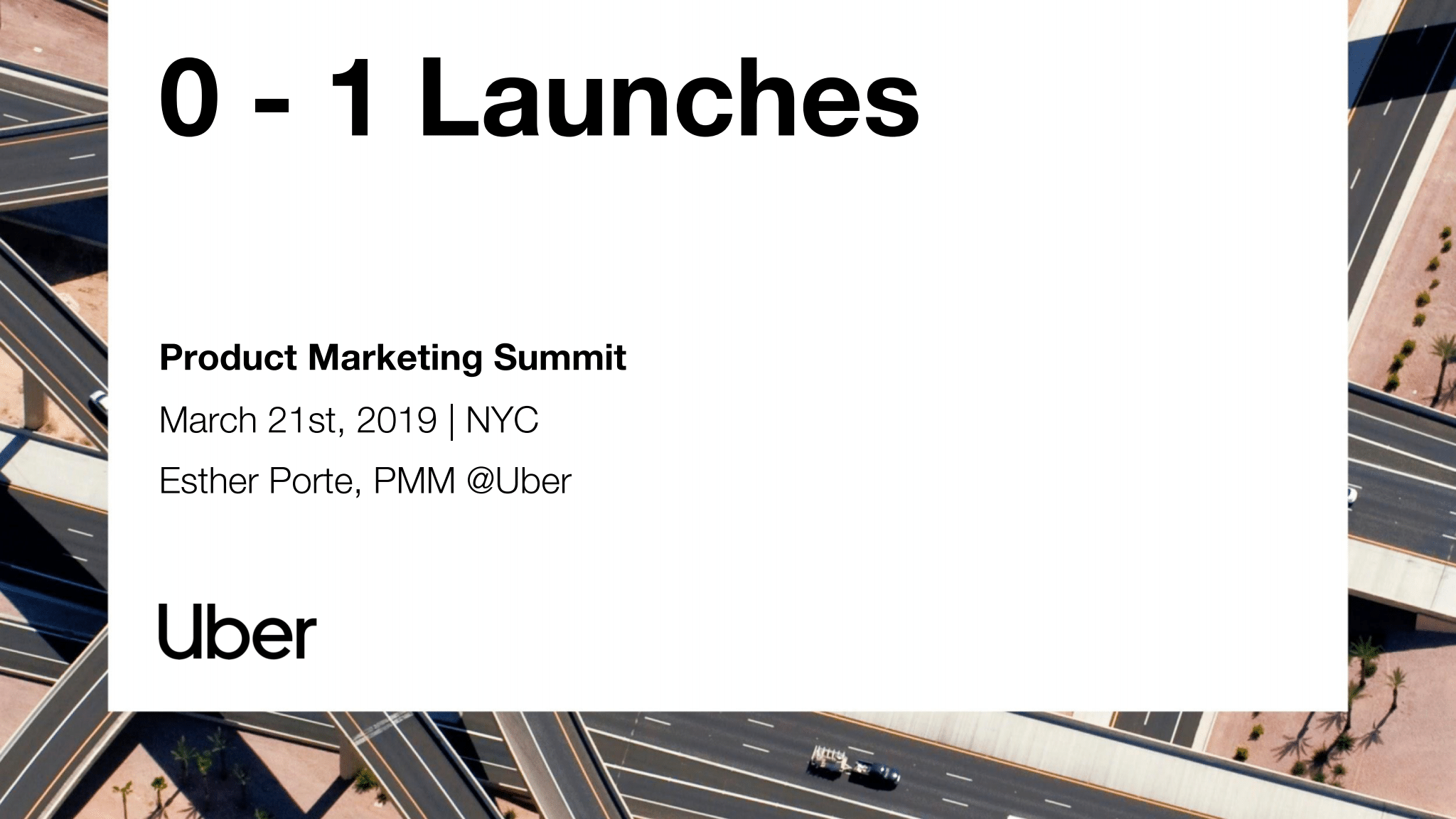
"Five years ago, if I had come to this conference and made a presentation I would be talking about UberX and Rideshare.
Five years later, this is what PMMs can be working on at Uber. New mission statement, new color palette and new products."
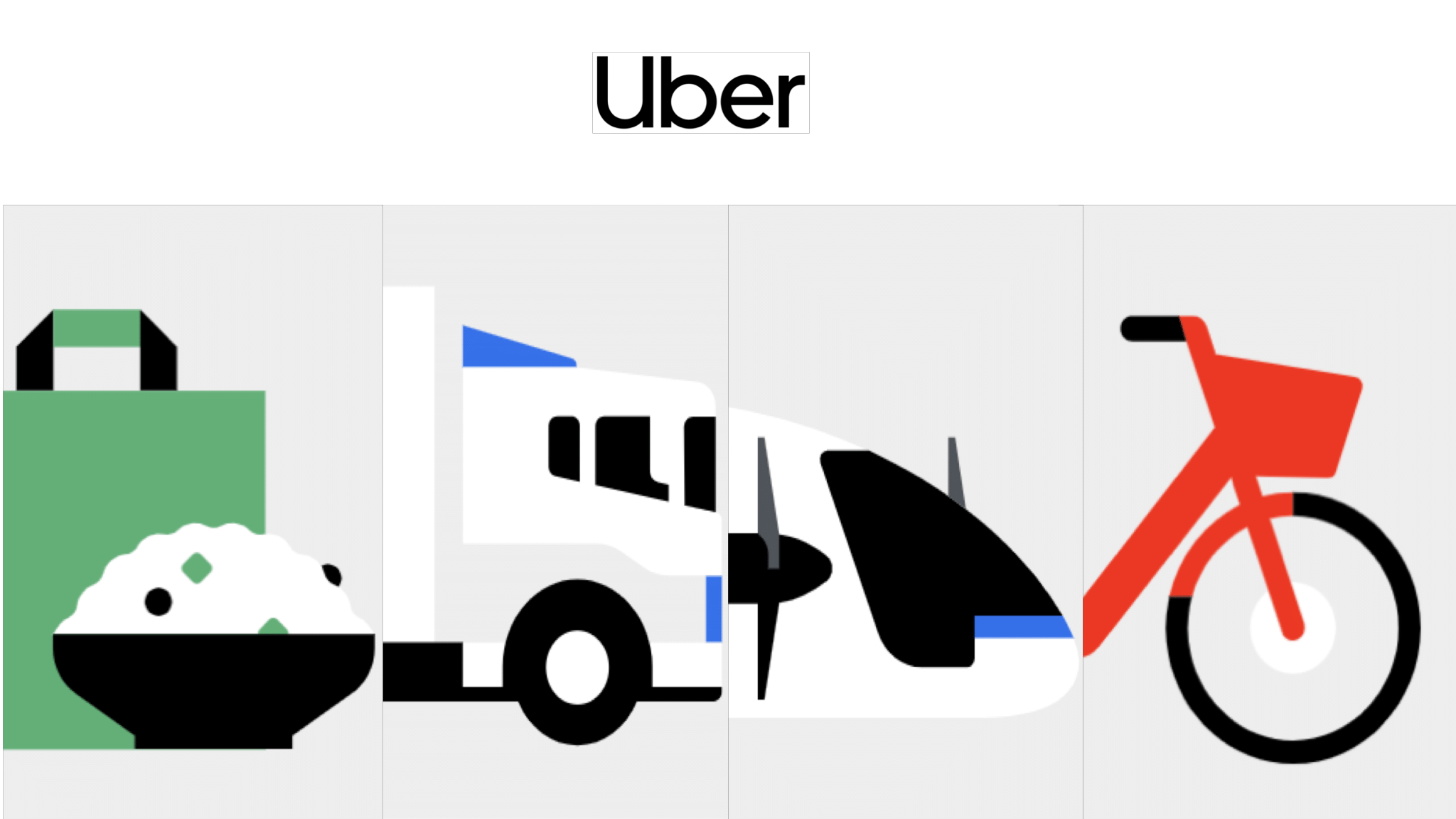
"I am not going to ask you to name all of those, unless someone really wants to. But, you have Uber Eats which launched about five years ago in the US. Then you have Uber Freight that's matching couriers and shippers. Uber Elevate, bringing a new dimension to ride sharing and Jump. So I'll focus this presentation on JUMP specifically, which is a product I've been working on for the last year or so."
"Quick intro. My name is Esther."

"I come from France - you've probably heard my accent already. I have been living in San Francisco for about five years. I really try super hard to look like a San Franciscan. I spend all my weekend hiking. And I have been at Uber for about two and a half years, working on driver products first and then more recently on everything mobility related. I would love to get to know you all so let's do a little quant analysis before to do so. And I promise I won't share any data. Who here is a PMM? Wow. Okay, who is an aspiring PMM? Okay, and who works in tech?"
"Great. So, quick agenda for today. I'll speak about what a PMM does at Uber, although I know we all have a lot of context and I see many of you are PMMs already but maybe we'll see some differences. And then I'll speak about how we'll launch bikes and scooters which are 0-1 products in the Uber universe. Then the JUMP brand, since we have the opportunity to have the bike here in the office right next door. I'll think about how JUMP is positioned. Then forward looking, how our PMMs at Uber are shaping the next vision of what Uber will be in the near future. And then a Q&A hopefully."

"I think this is probably very similar across companies and I see a lot of you are [working] in tech today. At Uber, the way that we see PMMs is people who need to be super well aware of the market, the product and the user. We are the voice of the customer within our product team. Also, of course we help in bringing this product to life. We are right and left brained. We work with our creative team and our marketers to build this campaign and to build epic narrative and to infuse that later into the product. We also drive impact to the business. Those impacts can be measured by different type of key results like opt0-in, growth, adoption, re-engagement, all of these are key results that PMMs are owning."
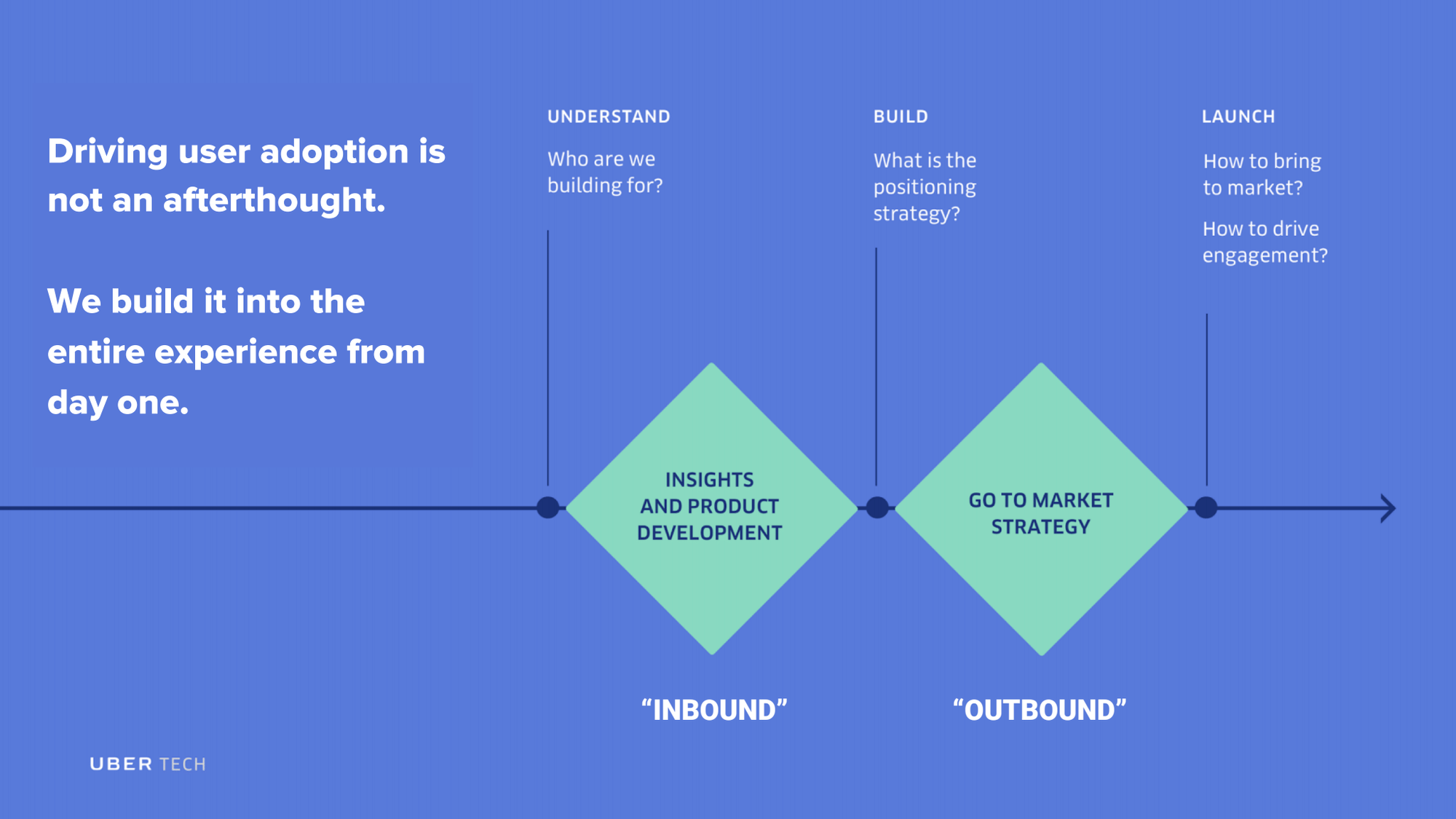
"This is what I call the the Double Diamond. It's a view of what a PMM really does in a tech company and in other type of companies as well."
"We first help bring the market to the product. And then once we do that, and once we make sure the whole product team can really understand who the users are, we build a product with them and then help bring this product to market."
"The core challenge as PMM is to align a brand strategy or a brand vision with a product and all the different features that a company is building. So, sometimes that means working really closely with a marketing team to build a narrative around a product that is being billed."
"At Uber, for instance, if you take a product that was launched last year called Uber Lite, this came from consumer insights. We realized in some countries like India (I used to work on developing countries before working on mobility), our drivers and even our riders didn't have the type of phones or devices or spaces on their phones that we do have in EMEA or the US. They couldn't use all the features that we had built for so many months or years in our HQ in San Francisco. So, we decided to build an app specifically designed for these mega-regions. And we actually launched that app in India first. This is where marketing and product marketing would directly influence what the product roadmap was going to be on the other end."
"Last year was a pretty busy year for us. In 2017, Uber went ahead and tried to re-earn drivers trust. That was a big challenge. It took us 180 days because the company was called 180 days. And during that time period, we built a bunch of features with all the products that you could imagine so to really earn that trust back. And so we built stuff like tipping or primary support, or smaller cancellation rate for providers, so drivers wouldn't have to wait when the rider might be too drunk to know if they really want to take that ride."
"All of these are things that PMMs collaborate really closely with product teams on. We are a cross-functional team."

"I believe that [this is] pretty similar to all the PMMs I've been talking to here. We are embedded in product teams. We do share some OKRs. And, as I was saying before, we do own specific key results. And we work though with a bunch of different teams like CRMs. Uber has a separate marketing organisation with all the different channels you could imagine. We work with policy. Specifically in that campaign I just mentioned when targeting drivers, we work with business development, and also our different mega regional marketing teams all across the world. So, for a product like Lite that launched in India first, as PMMs, you really have to travel there and understand the market and stay for a month to really understand deeply what the needs are."
"This slide gathers the two different sides I was presenting before."

"This is where a PMM influenced the roadmap of a product lifecycle. But also these are the different key partners we work with at each of the different state stages of the product lifecycle."
"I also like this next slide because I think some companies are resourced differently. But, PMMs can either be on the outbound side of the house or on the inbound."

"At Uber, we try to have a seat at the strategic table when vision is being discussed about what a product should actually achieve. Although, we do work closely with Content Strategists, Serum Analysts, and all the above to actually bring this campaign to life. We do follow all this execution really closely and we work with PMs to define what the strategy should look like."
"Key takeaways?"
"PMMing/Product Marketing: we have a global role because of the nature of the business, and we work with in-market counterparts. But, we influence a different moment and we do own specific OKRs in this in this product map. Any questions before I move on? Okay, I think we keep that until the end. I'll just follow the rules!"

"I've been working on these products before Uber acquired JUMP. That was in April last year. First, why did Uber decide to invest in these types of products and how did we bring this this product to life in a company that people really know for ride share (even more abroad than in the US)."
"First of all, it all starts with, as usual, data. So we looked at all the trips that are happening in urban areas, and we classified them in separate categories."
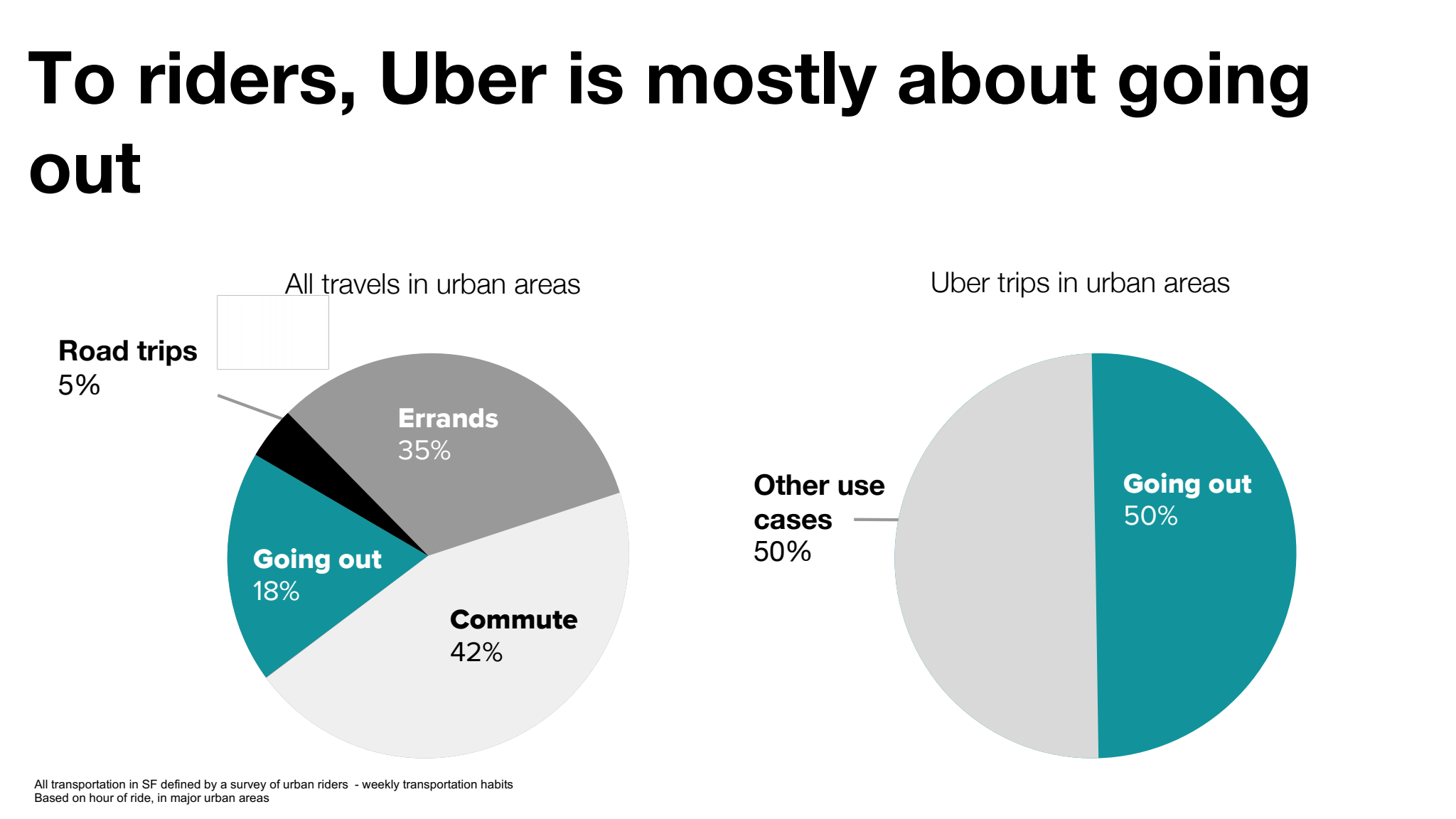
"What you can actually see, and this is probably not very surprising to any of us, but commute and errands are the two brother categories that you can see in urban areas, whilst going out is actually only around 18 to 20%.
Uber really does capture a lot of those 'going out' social trips. 'Errands' are different from 'going out'. As a European myself I was not really sure. Errands really mean picking up your children from school or doing the groceries. Anything that's not social and where you have a goal in your trip.
So, Uber is really good at 'going out', but we are clearly missing out on too many opportunities. [They are] commutes and errands."

"Why? It's pretty straightforward."
"When commuting, you might get stuck in traffic, or it's too expensive (even though we rolled out some specific products like Express Pool to make your ride even cheaper.) For running errands, if you want to go out for two days, then Uber is not the best way to go."
"Although we are well aware of missing out on these opportunities, we tried different stuff on to get bigger in that space. But, what we really realized in the last 2/3 years was that two main trends were actually kicking off - bike share and E-Scooter."
"So, with bike share, if you look at what happened then 2015/2016, we realized that the global run rate of that industry was multiplied by almost four in a year. That growth was led by two main Chinese companies, ofo and mobike. Then on the other end, a bit more recently in 2017, and this is what you can see here on the slide, the E scooter industry had the highest growth ever."

"In less than 12 months, the adoption rates in the US industry were about 3.6%. That means that 3.6% of the people in major US cities have actually tried one of these products. This is huge. If you look at ride share and how Uber was doing for that same metric, it was actually much lower."
"So we're like, 'hey, well, these two products, have found a great product market fit and also are experiencing a very fast adoption.' The good news is for us, this means we are now able to capture short and mid-distance trips, but also provide a much more affordable commute option. This is an everyday price. This solves these categories of trips which we were not really capturing before."

"As PMMs, we articulated that in our narrative, and pitched to the different marketing creative designers we were working with, 'Let's focus on highlighting the fact that we have now a new option in our app, which is something very new for a rider. But also let's feel the fun and the freedom of these new products.' We wanted to share the feeling that you can cruise by traffic on two wheels."
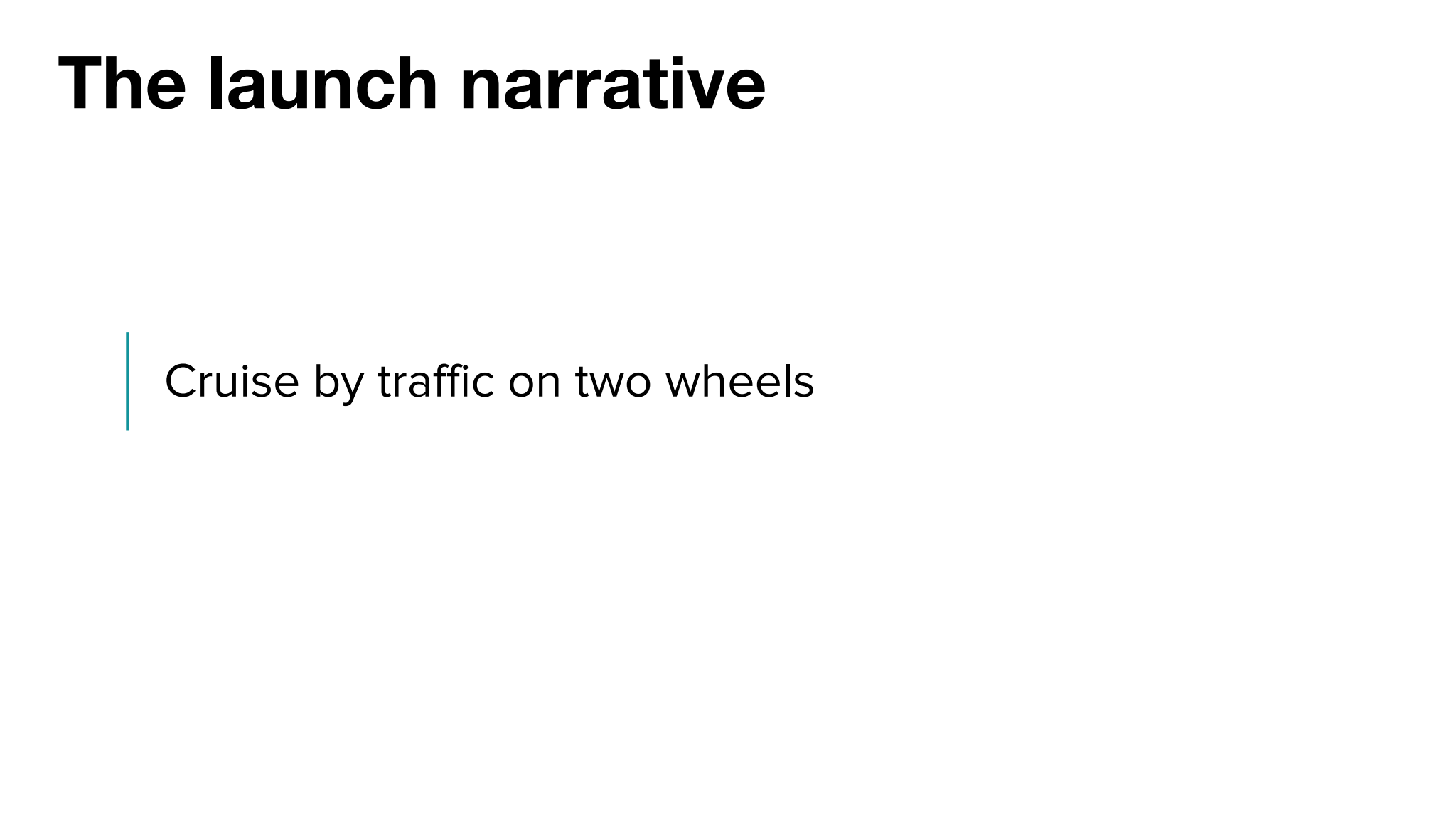
"When you're riding this bike, you're flying. And this notion of feeling like a superhero was something we've heard over and over again. And I wish we could see the first video because someone actually says it, and I promise we didn't pay her for that. It's actually what everyone says."
"So, the first few months have been for us to focus on introducing bikes and make people aware of it in the Uber app. As PMMs, we work on how we position these two products (bike and scooter)."

"We launched scooters about four months after launching bikes and we learned a lot about how we launched bikes to how we launched Scooters. But I'll focus a bit more on bikes for this presentation."
"The value props that we introduced in all our different assets were first [the ability to] cruise by traffic. It's more fun because you're not stuck in traffic. It's an everyday price. So again, coming from the customer insights, we know that people want for their commute, not only an affordable price, but also a consistent price, which is even more important than affordable. Knowing what you're going to pay so you can actually track your expenses and make plans. So everyday price and also convenience. We bring everything all in one app which something which is something we're really focused on for this marketing campaign too."
"So how did we bring this to life?"
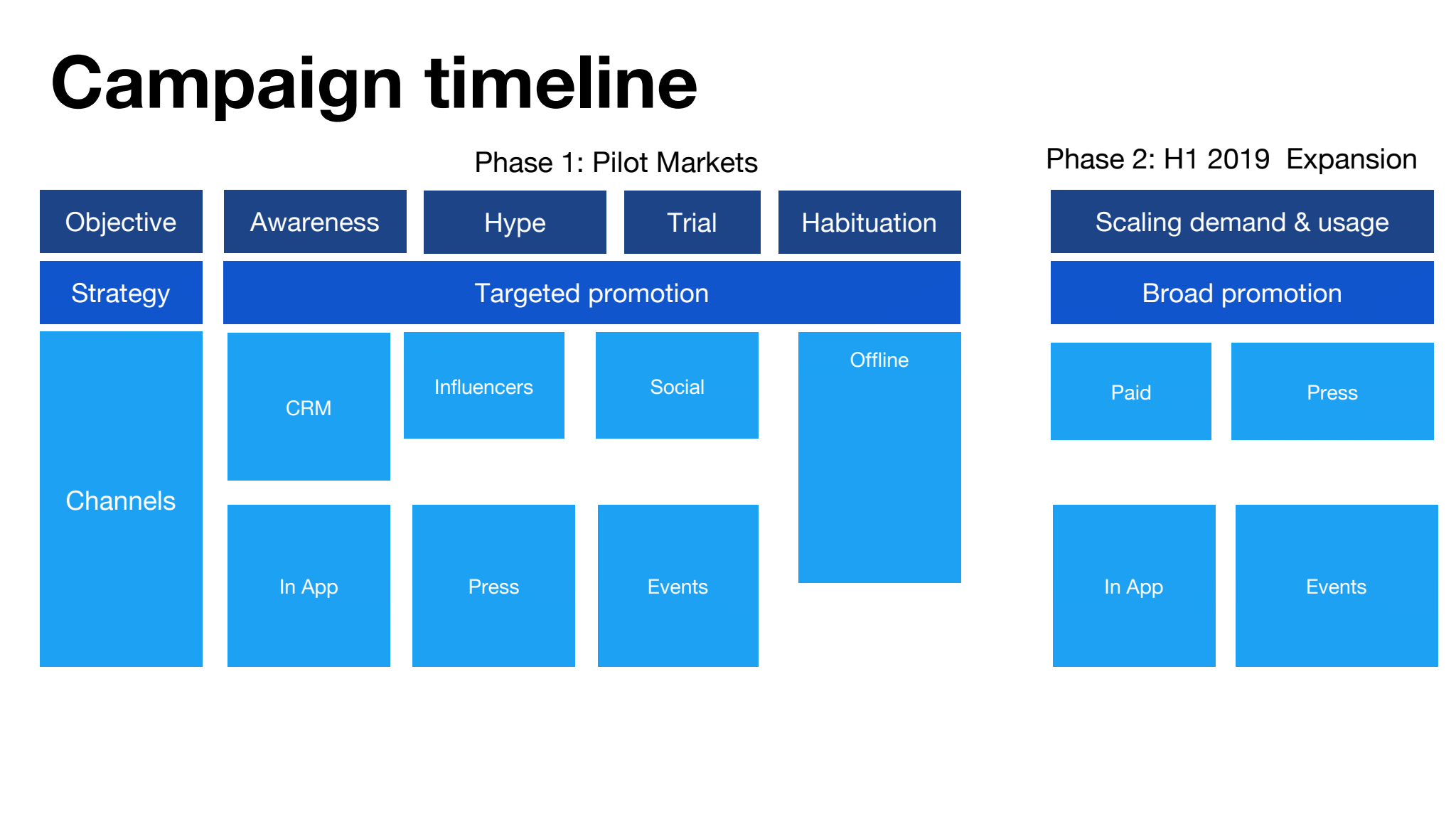
"As I said, we worked with many different teams. The way I've ranked the channels here is what we activated first and the size of the boxes. Mainly, it was most important to us when we did this campaign."
"CRM was a big one. I worked with influencers, did a lot of local events. We did one in DC, we did South Bay recently. In almost all the city we were a real launch. We launched recently in Lisbon. Our second, after our soft launch in Berlin, EMEA market launch. And in App is also, of course, a channel that PMMs do deeply care about."
"So, right now we've just moved from the pilot phase and we're moving to the growth and expansion phase now in 2019. We're leveraging other channels, like paid for instance. Here are examples of assets we've been developing."
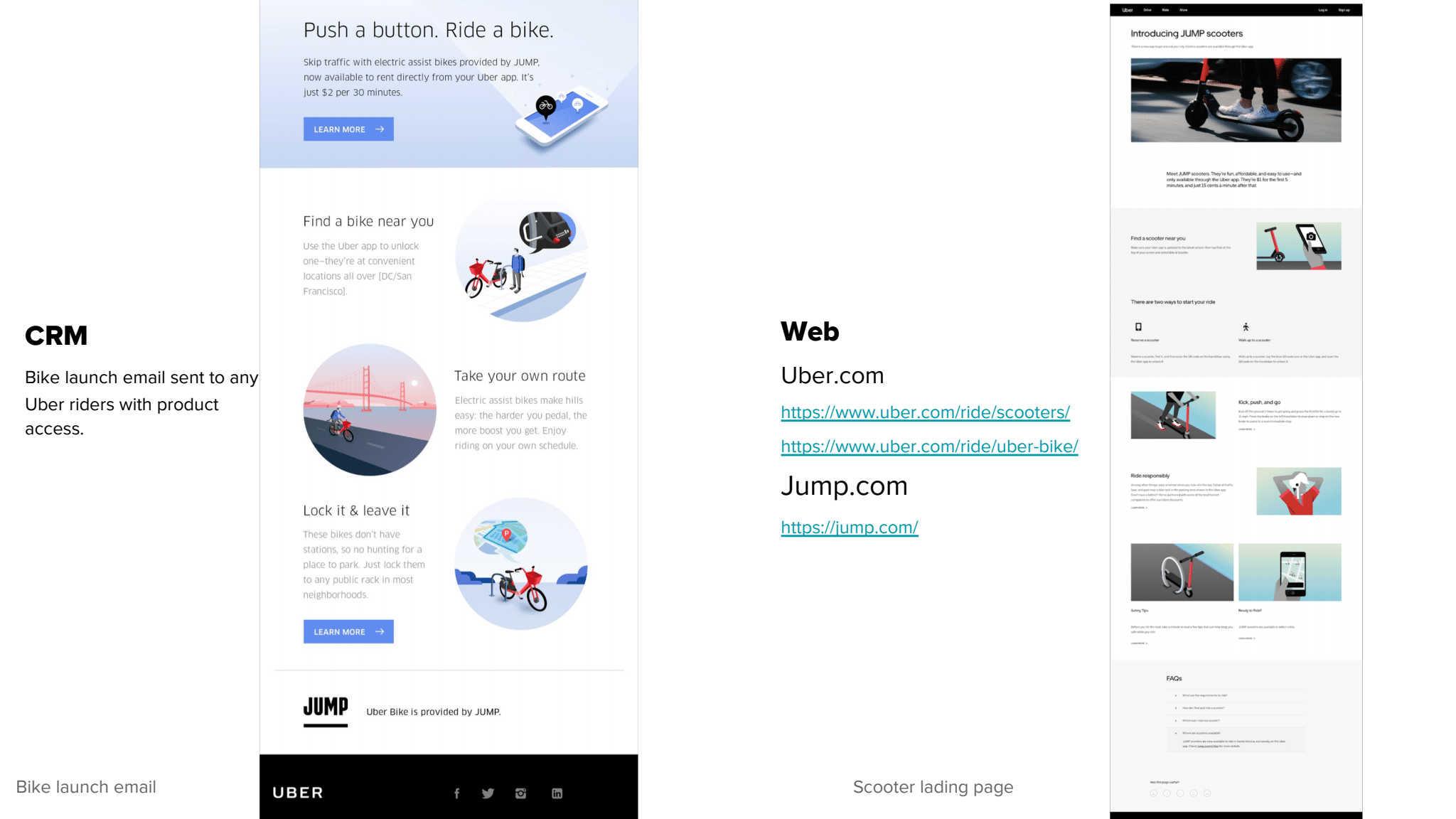
"This is again stuff that PMS have really partnered with CRM teams and our web teams on. We have a website on Uber.com but also on Jump.com."
"Someone was mentioning this morning, how, when you roll out, do you do a first weightless type of launch. That's exactly what we did for San Francisco, for instance, since our service area first was actually really limited to downtown. And so we emailed a couple of people who knew our trips were actually happening in that area, to of then course expand later on when our service area was expanding as well."
"So, we focus a lot, and I'll talk about this a bit more later, on 'how to' and safety. These were decisions that were made by PMMs because we realized that for such a new product, because this is an E bike, and it's dock-less, people just don't really know where to leave the bike, where to ride, how it works."
"How do you lock it? How do you put it on hold? So all of this, we had to decide 'Where does this content fit?' Where is it not too overwhelming to have all this content at first? We of course work with, as I was saying before, Press and PR and that was really important in all our pushes. We usually start first with a big PR push, and then work with our different channel owners to launch all the different campaigns. So, this is for the partnership and we had another press-push during the acquisition that happened in April."

"And you can see here again that the angle the press chose to deliver the message on was really innovation and convenience all in one app. Uber differentiating itself by going beyond reach only."
"This is again, something that PMM and PR collaborated on and brought to life.
Another channel that I really do like and we spend a lot of time on was obviously PMM product. So, where do we locate the entry point to this product? The thing to know is for tech reasons and also before we actually prove product market fit, we didn't want to disturb what we call the product selector, which is where you actually choose your mode, between Uber x or Uber pool or Van - this place in your app. So we partnered with designers to think about where else could we actually place an entry point."

"And that was really interesting. We ran some tests, and we had different ideas. Some were absolutely not feasible, some were much more feasible. And the one we chose first was what you can see on your left, This side bar menu where we added an entry point to bike. We quickly realized people never go to this sidebar menu in the app. The only time you go there is when when you need help when you want to get your payment method, but never when you need an on demand trip."
"And so we did some stuff, we experimented, we A/ B tested. We tried to add a badge, which is this red dot, and hoped people would click saying this red dot the on the side. We tested colors too. Red was pretty stressful. Then we tested green. Green was , 'oh I need to update something - is my credit card expired?' And then we ended up with blue. All of this takes several weeks of iteration, and we tested copy too obviously. And then after that, we moved to what you have now in your app. And if you're in a city where you have access to two Bike and Scooters, we have what we call mode switch, so we move from the side menu to back on the map to create more in App discoverability. And that was harder to build for sure, but obviously drove much more adoption. Results speak for themselves."
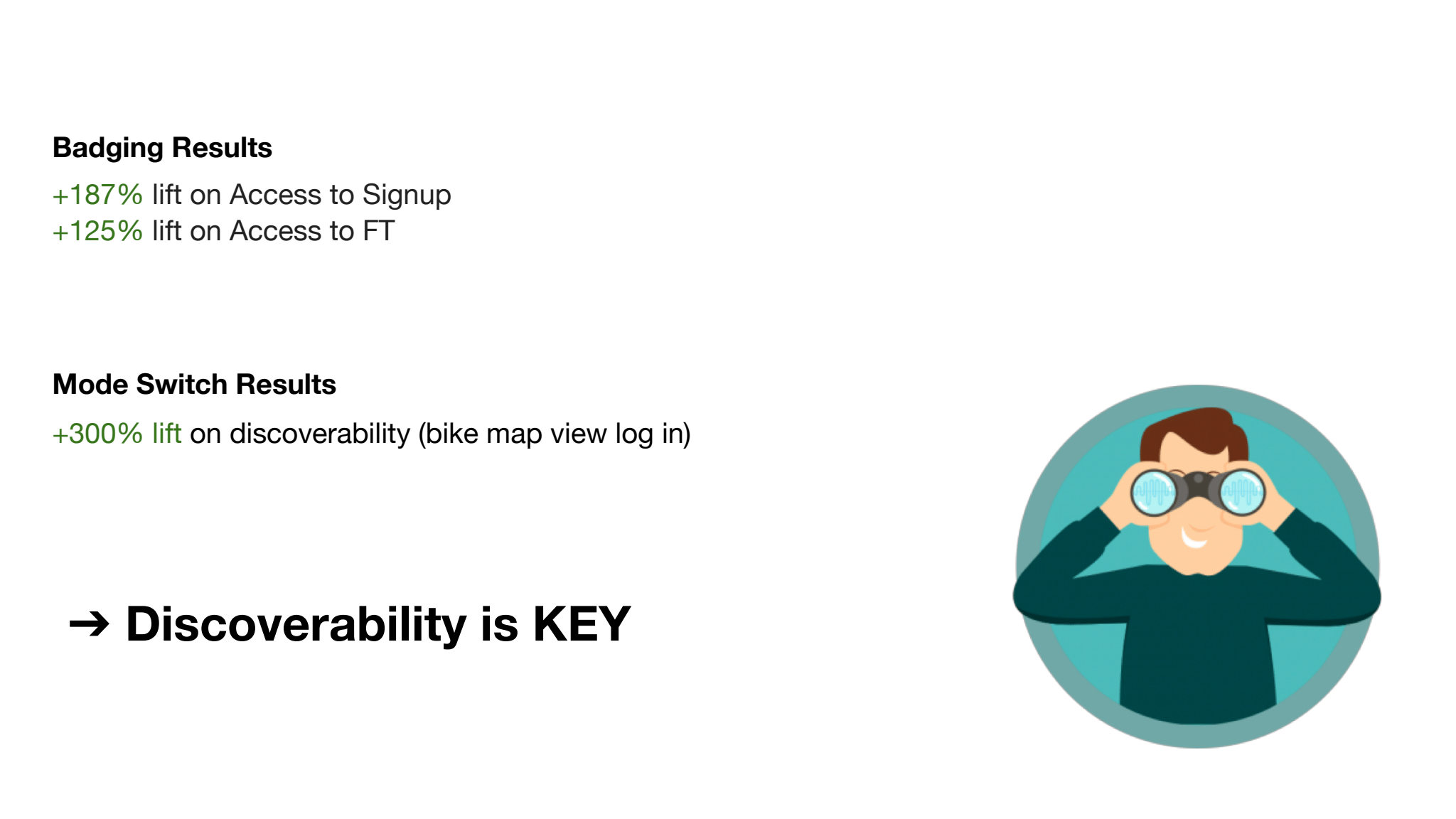
"We had, for the badge experiments, almost 200% lift on access to sign up. Access being when someone just clicks on the word bike, and sign-up is when you've onboarded and gone through all the new user flow."
"Also, the access to first trip was also a huge lift, first trip being when you take your first bike ride, for instance. And on the mode switch results we had an even higher lift, since this is a much more 'discoverable' experience. The bike view being exactly on your home map when you open your app. So, 'discoverability' is key. We knew it, but it took us a long time to get there."
"And we haven't finished iterating, but this is where we are today."

"JUMP brand - let me introduce these beautiful shiny red bikes and rentals since now we have more than one vehicle under this portfolio."
"It's funny because we acquired JUMP first and then we had a whole Uber brand redesign. And actually the way Uber redesigned is on brand and the mission was to be much closer to how Jump defines itself. Uber tends to be now a little bit more bolder, closer to it's rider and driver community. It's more fun, there's more color."
"And JUMP is all about that. The color is red. It's shiny red. This is a bold choice that the JUMP team made when they created their first bike. This is all about fun and you can really see that in all the content that this team deploy. I'll show some pictures."
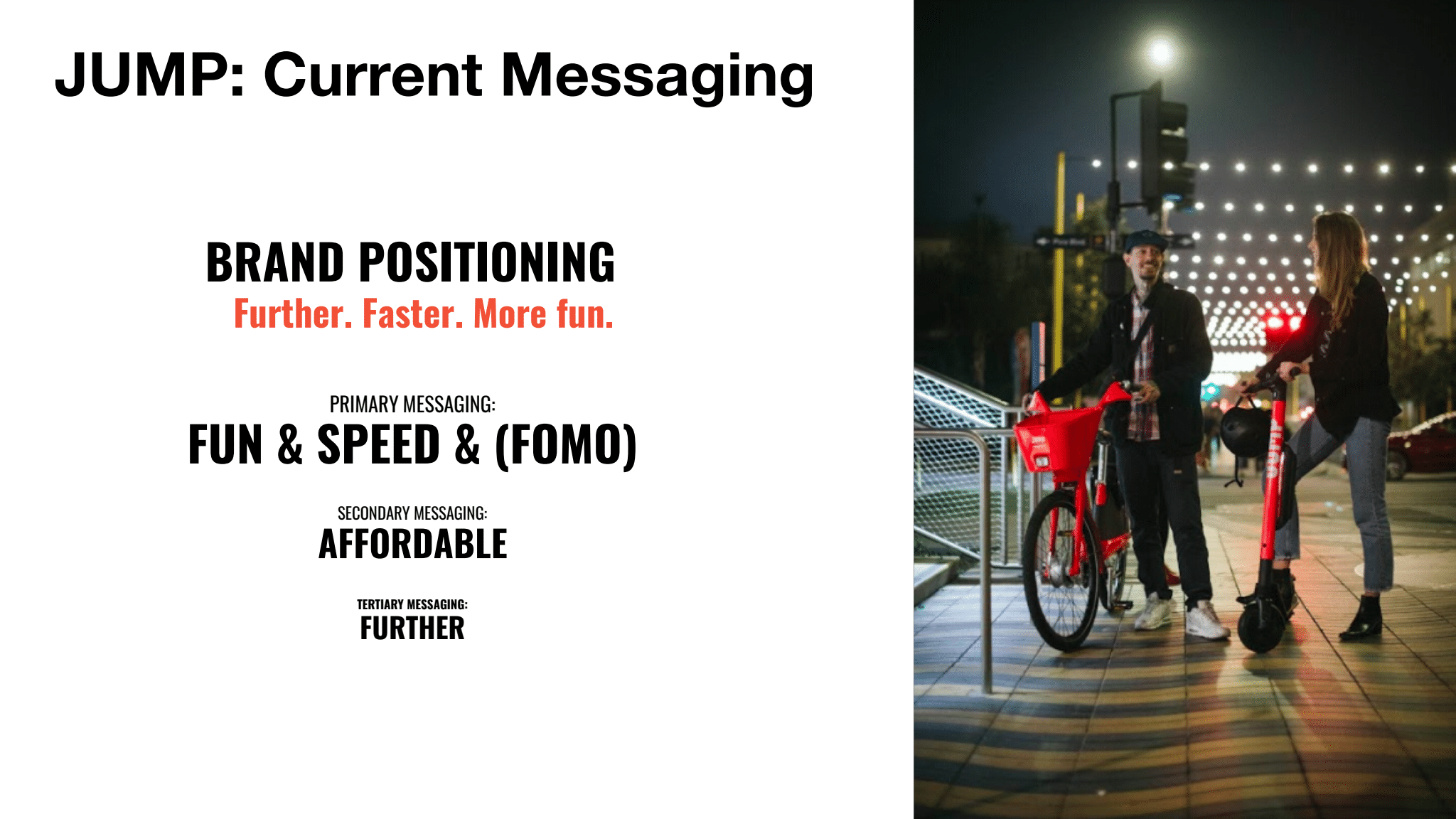
"Even the type of people we use for our photo shoots is something we really think deeply about and we spend weeks talking about. I think we really want to show that this is for anyone."
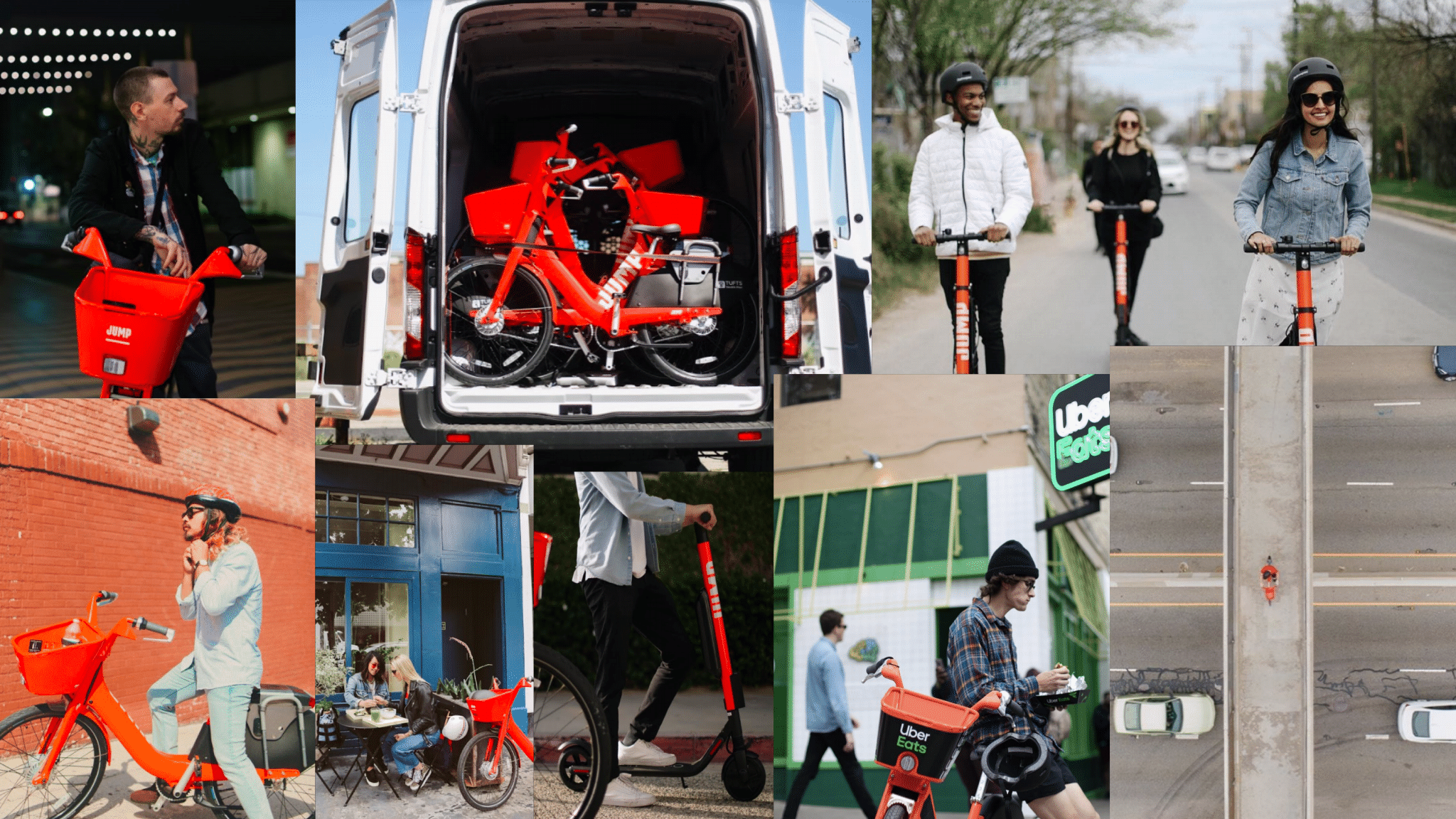
"This is an affordable way to get where you want to go faster and bolder.
Safety is a big piece of our work as PMMs. We make sure we provide the right level of information. We don't enforce, we cannot force you to take specific action. But we want you to have all the key elements to make those decisions. The Uber Eats time frame was actually interesting. We tried this co-branding and messaging on our bikes at the South Bay event last week.
So, how did we decide to really talk and introduce safety in such a new, 0-1 type of product. Using different channels in product is really key for us."
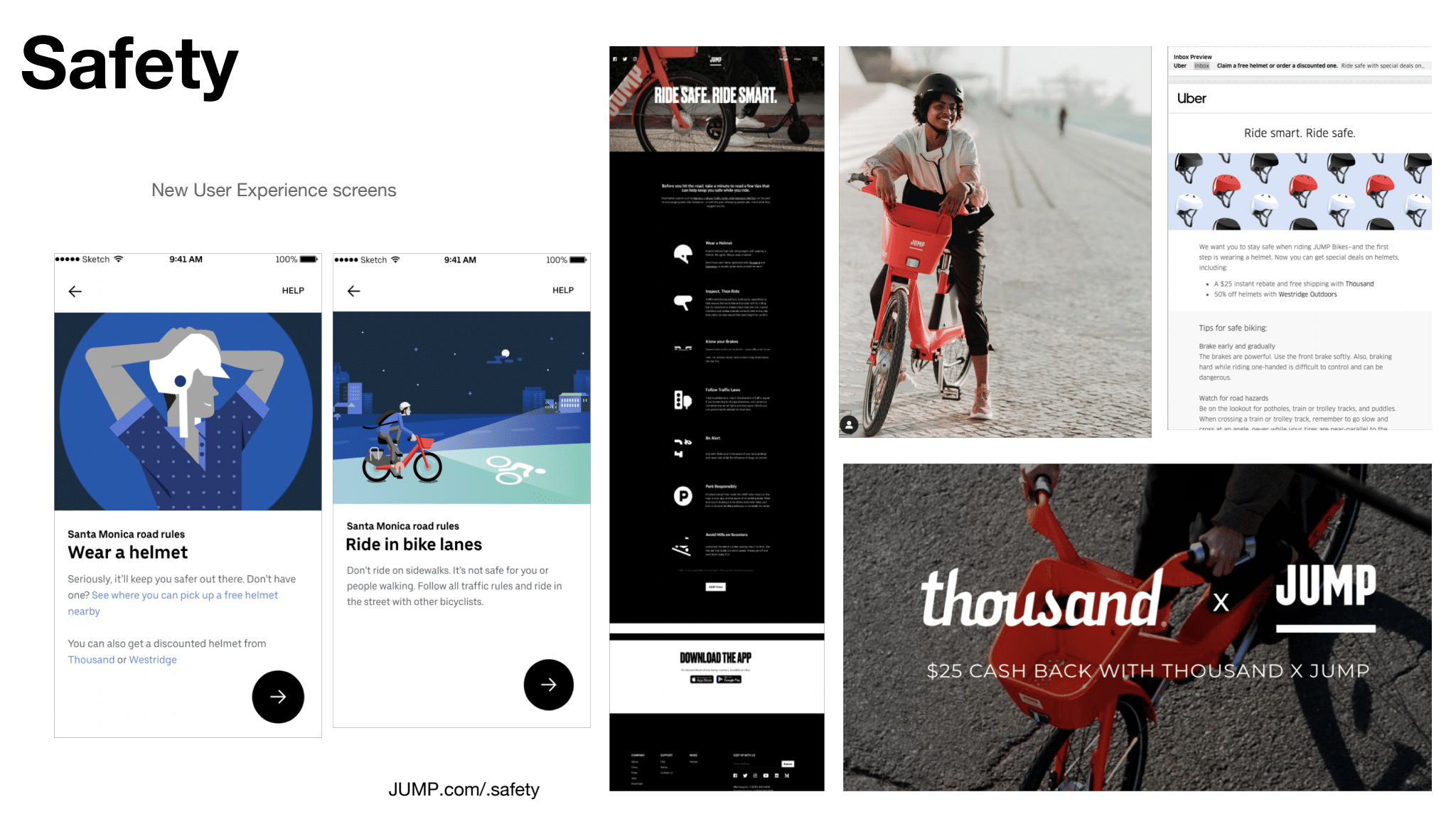
"As a new user, you have to go through a couple of onboarding screens, and we show you where to ride, how to wear a helmet and even link you to a landing page to find a discounted helmet. So, we're partnered with two companies called Retrospect and Thousand, and we give you the opportunity to get discounted helmets."
"On CRM and all our social assets, we make sure people are wearing helmets or riding than need to ride. And these are all little elements, but we make sure we have this consistent message around how to promote safety."

"So, forward looking. This is, what PMMs and this team, really focus on today. We've launched products that are new to everyone. But this is not where we want to stop. Uber as a platform is where we want to go. And we have launched several pilots, and we're really working on positioning this pilot and explaining the message behind those pilots to move towards that later vision. Sometimes the vision can be a year ahead, sometimes it may be five and sometimes truly, you don't know. And this is the case."
"We've launched two pilots one in Denver. So, anyone who's in Denver, I think I talked to someone who was in Denver earlier today, we've launched this pilot, where we partner with transit agencies to show that it's a journey of planning. This is what the MVP is today, where you can have on top of all the different options, and I believe we have bikes available there too. "

"We, on top of these different modes, we also offer you a view on what are the closest lines available to you if you want to go somewhere. This of course improves our relationship with transit agencies. This facilitates our journey of planning and it offers again one platform to view it all. But also for us, there's an increase in the frequency of sessions in the Uber app and first trips that people would take. The site has been live for a little bit, so we can all access it. It's public - its movement.uber.com. And, Uber Movement is showing in any given city at any given time,showing a travel time between a pickup and a drop off location that you can choose on the map. And this really helps cities address transportation challenges, related to things like sustainability, access, congestion, equity, data. We use our aggregated anonymous data to do that."

"The challenge here for PMMs is what is the story behind that? Who do we talk to within city administrations? How do we communicate this to our riders because at the end of the day, we want to the rider to know what we are doing for their cities. These are all discussions that are ongoing, so nothing I can really share there. But this is how PMMs are thinking strategically about where we want to go in the future."
"The first launch positioning was cruise on two wheels by traffic, feel the fun, feel the freedom. And now the long term narrative that we're trying to get to is, your go to transportation of choice. And the question is, how do we get there? What are the different steps in App, with all the different cross functional teams, that we need to take to actually get there?"
"Thank you so much."
["Any questions for Esther?"]
[Question] "Thank you for the presentation. At the beginning, you talked about shared OKRs with the product team. Can you give some examples of what those are?"
"All the examples of shared OKRs were when we launched bikes. Awareness is one, making sure people know about the bikes. However, how you get there, there are some things that PMs can do on their own. But, making sure you actually find the best entry points in App is something that a Product Marketer would own. There is one function I haven't really talked about so much, that is UX research. As PMMs, you really work closely with a team to make sure anything you do, any test you actually experiment, you do test it with real users. So this all comes back to things we've heard before - testing, iterating. Awareness, for instance, is one OKR that is truly owned by product marketers, but as a product team. We had an objective on that awareness. After x month after launch, x/ y percent of people have heard about your bike."
[Question] "My question is in terms of switching people's mindsets around in regards to taking a bike or taking a scooter. Obviously, people take Uber in a car because that's in their head, their mode of transportation. But people who ride bikes are people ride bikes and people who drive are drivers. So how do you shift that and get people to try out biking? And then my second fold of that question is, why wouldn't somebody who does enjoy biking just buy their own bike because it's not that big a price hurdle, as in with a car where you'd have to pay for a vehicle?"
"Great question. So I'll take the first [part]."
"Of course, bike share, has been around for a while. So if people have not tried this before, why would they try this now? Docked bike sharing has existed for for a while. You have Citybike here. But, the way we've approached this is really to highlight the fun and what is different from being on a bike versus being in a car. This is why we focus on commute, for instance, again, this is really focused on urban areas. This wouldn't work so well if you live in the suburbs. But we focused on the time you spend in a car, even in a ride share car. When we first launched those different assets and campaigns, there were some pretty tight discussions with the ride share team because people were afraid of cannibalization which did not happen and this is something we proved by data. So we really focus on, what do we know you are expecting from your commute to be pleasant? What are the pain point that you experience as a customer, even with a different option that we offer you today? We took those pain points, we found the solution was bike share and scooters. And this is what we really highlighted in our communications."
"A lot of people who actually have tried JUMP, at the beginning, were previous Bike Share users in the past and really liked the fact that it was dock-less.
We are seeing more and more people who have not tried a bike at all try these bikes. I think this takes time there is so much we can do in app, even without moving billboards. I think it's also a question of time until people actually are aware that this exists."
"To your second point, though. Why would people not buy a JUMP bike? That's a question we are asking ourslelf a lot and we're trying to make the unit economics work on our favor. But one thing that's pretty obvious with dockless is, first of all, an eBike can be pretty expensive. And not everyone really wants to spend $2,000 on an eBike. And dockless is something that really people find super convenient, not having to bring it back, park it somewhere, you know, the risk of of this being stolen. These are all real risks that you wouldn't really have with JUMP bikes. I personally live up a big hill in San Francisco. It's would be nightmare if I had to go with my own bike every day. So, I usually commute to work with my bike and check another option to come back."
[Question]"I'm curious to know that, let's say in a market like the Netherlands, where bike is the USP of Amsterdam, for instance, or where people come all over the world, and they want to experience that, or something like India that does not have a bike track, but a lot of people biking there. These markets seem to be averse to this idea because they already have something or the other in place. Whose call is it to decide whether those markets need to be entered? Is it PMMs or the marketing team? And if it is a marketing team, do PMMs get to take the call on the viability of doing so and going ahead with it?"
"What it is that you mentioned for Amsterdam?"
"Yeah, they have a good biking system and India where everybody owns a bike, but there are no trails."
"Yeah, totally. This is a very good question. We build up our own market entry team, because on top of where we want to go, this is also where we are allowed to go. And winning permits can take time and it's pretty difficult. As far as we decide where we want to go, we have this market entry team working super closely with SMP or Ops, because there are many factors from financial but also as you said, culturally. Is this working? Can we find warehouses where we can actually park those bikes? What is safety like there? All these different outbound factors, it's not necessarily the PMM job to do that. It is more this team of market entry and also local teams since we have the chance to have mega-regional teams everywhere, to really let us know if there is an appetite for for this type of products on the ground."
[Question]"Obviously, Uber and Lyft have been neck and neck. I'd love to know if Product Marketing at Uber has any role in addressing competitors or competing with competitors. Obviously has to be done tactfully. I just wonder if you guys have done anything like that."
"I wouldn't say PMM specifically, we'll look at all the great things that are happening in the industry. For sure it happened that Uber and Lyft have gone into the same direction as a platform. I think in terms of like creative messaging, this is where we would sometimes take a look at what is done externally. Not necessarily only in the writer space. But, I wouldn't say it influences our strategy as much. As PMMs, the tech is different, their product team are structured differently. So we do look at what is available in house to tell our story, and then maybe in the how to tell the story, this is where we would look at what is done externally, but I wouldn't say it influenced our work on a day to day so much."
["All right, we got it. I've got to cut everybody off."]
"Thank you."

